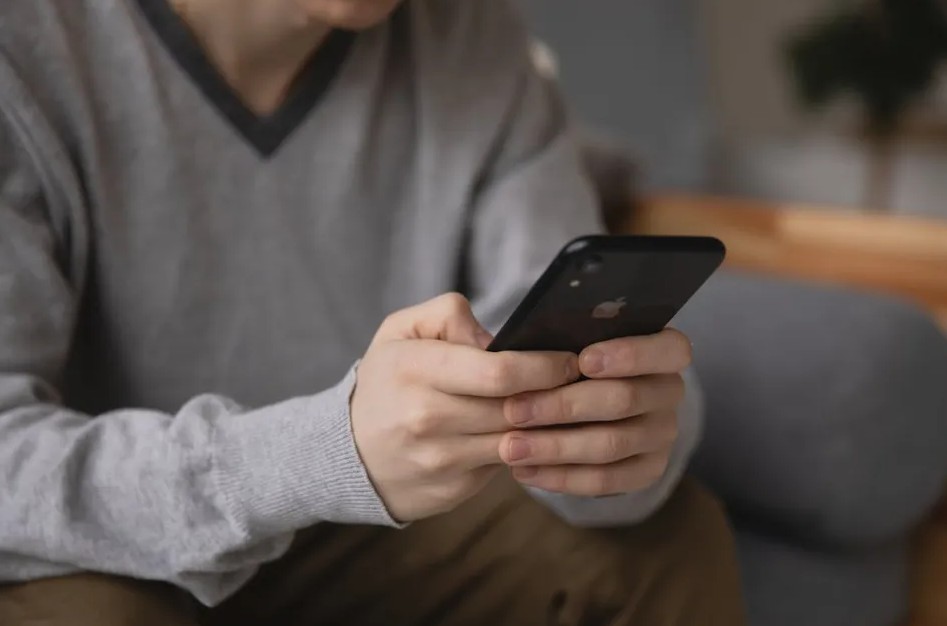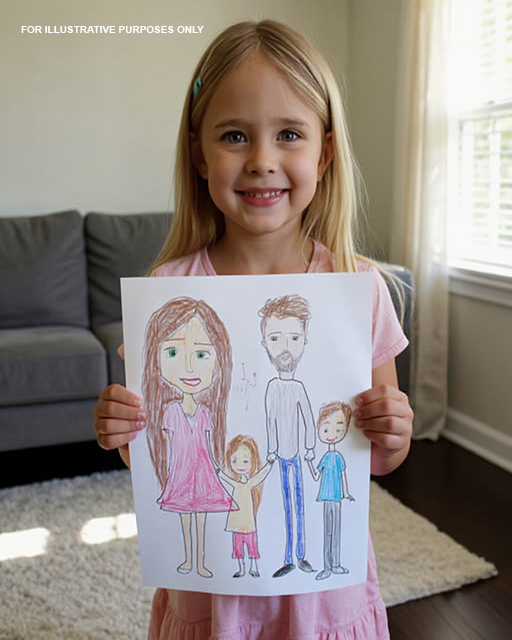When I stepped into motherhood, I vowed to always cherish and encourage my daughter’s creativity. I wanted her to express herself freely—drawing, singing, and dreaming boundlessly—just as I had once done before reality taught me how swiftly hopes can shatter.
So, when she burst into the kitchen one bright Saturday morning, clutching her crayons with a beaming smile that could soften any heart, I didn’t suspect anything unusual. “Mommy, look! I drew our family!” she exclaimed, holding a freshly created picture warmed by her tiny hands.
While scrambling eggs, I glanced over and saw the painting: a charmingly imperfect portrayal in vivid purples, yellows, and greens. The figures included me with my flowing hair, my husband with his short brown locks and broad grin, and our daughter clad in her beloved pink dress. The sun radiated from the corner, flowers adorned the grassy patch, and in her endearing style, little hearts floated above our heads.
Yet, my eyes caught something else—a fourth figure.
A young boy stood beside her, holding her hand. His hair was dark, and he wore a blue shirt. Unlike her usually abstract or sloppy sketches, this figure was drawn with unusual precision. This wasn’t an arbitrary stick figure; it was a representation of someone real.
Trying to stay composed, I asked, “And who might this be, sweetheart?”
Her shining brown eyes—mirroring her father’s—met mine as she cheerfully answered, “That’s my brother!”
My hand paused midair. “Your brother?” I echoed, striving to sound casual. “Do you mean your cousin?”
She shook her head decidedly. “No, Mommy. My brother. Sometimes he plays with me when you and Daddy are asleep.”
My stomach knotted—not out of fear, but puzzlement. “What do you mean he plays with you?”
She shrugged as if it was the simplest truth. “He comes to my room, and we play house. He’s very nice.”
Uncertain whether to worry or laugh, I remembered children often invent imaginary companions at this age. Her description seemed innocent, so I chuckled softly, kissed her forehead, and offered, “That’s a beautiful drawing. Let’s put it on the fridge.”
Still, the boy’s face lingered in my thoughts—the careful detailing, the distinct features. Somehow, he seemed familiar.
At first, I dismissed it as mere coincidence.
But throughout the week, subtle signs unsettled me.
My husband, David, had grown increasingly distant and preoccupied. He, who used to be so involved—bedtime stories, weekend Lego castles—had lately seemed restless, extending work hours with claimed meetings and sudden calls.
Whenever I inquired, he offered a charming smile and reassured, “Just work stress, honey. No worries.” Yet, I noticed his phone lighting up late at night and stepping aside for private conversations. On one occasion, I glimpsed a contact named “Anna” before he quickly turned his screen away.

I wanted to believe it was nothing. After all, seven years together, a college romance blossoming into marriage, occasional quarrels but a foundation of love I trusted deeply.
Still, my daughter’s talk about “her brother” persisted.
One evening, while tucking her in, she whispered, “He said he misses Daddy.”
My hand halted on her blanket. “What did you say?”
She softly repeated, “He misses Daddy. He says Daddy doesn’t visit anymore.”
My heart pounded. “What’s his name?” I asked gently.
She furrowed her brow, thinking. “I don’t know. He didn’t say. But he looks like Daddy, see?” She pointed at the drawing on the fridge, her finger tracing the boy’s dark brown hair.
Sleep eluded me that night.
An unnamed, heavy suspicion grew inside me. I tried to rationalize: children absorb fragments from television, playground talk, cartoons. Maybe she’d overheard someone else’s story and imagined her own brother.
But deep down, I sensed she wasn’t inventing tales.
The following morning, after David left for work, I trusted my intuition and went to his study—a place he preferred kept ‘organized his way.’ His laptop stood open, and though a wave of guilt washed over me, my fingers moved on impulse.
Entering our anniversary date, his password unlocked the screen.
Emails, spreadsheets, and memos revealed nothing unusual initially. Yet, a folder labeled “Personal” caught my eye. Within it, a subfolder called “Misc” held unexpected content.
Inside, I found photographs I’d never seen: David smiling tenderly with a little boy no older than four. The resemblance was striking—identical brown hair and a matching cheek dimple. The snapshot was taken in a park far from our neighborhood, timestamped a year prior.
My hands trembled as I opened the next image. The child sat atop David’s shoulders, laughter shared between them. Nearby stood a woman—Anna—the same name displayed on David’s phone.
It felt as if the air had been sucked from the room.
My husband—the man I trusted—had another child.
For several moments, I stared blankly at the screen, grappling to comprehend. Maybe it was a misunderstanding; perhaps David was just helping Anna and her son. Yet, as I searched for plausible explanations, I realized the truth. My daughter had intuitively seen what I hadn’t yet—expressed with innocent clarity through her drawing.
The front door’s opening broke the silence.
David entered, loosening his tie. “Hey, sweetheart,” he greeted casually, pressing a quick kiss to my cheek. “What’s for dinner?”
I met his gaze, pondering how long he had maintained this duplicity. Quietly, I said, “We need to talk.”
He paused, sensing tension. “Sure. What’s wrong?”
Breathing deeply, I asked, “Who is Anna?”
His expression shifted immediately—panic flashing briefly before confusion masked it. “Anna? I don’t know what you mean.”
“Don’t lie,” I said firmly. “I saw her name on your phone, and the photos on your laptop.”
Paleness spread across his face. “You went through my things?”
“Don’t deflect,” I retorted. “Who is she? And who is that boy?”
Silence filled the room. Shoulders slumped and hands trembling, he sat on the couch, covering his face. “I never wanted you to discover this like this.”
The knot in my stomach tightened. “So it’s true?”
He nodded slowly. “Yes.”
My world seemed to tilt beneath me. “How long?”
Guilt marked his features. “Before we were married. Anna and I dated in college. We broke up. She didn’t tell me she was pregnant until we were already engaged. When she did, she said she didn’t want to disrupt my life. I tried to do the right thing quietly—supporting and visiting when I could.”
“And you kept this secret?”
His voice cracked. “I didn’t know how to tell you. The boy was already two years old when I found out.”
“Protect us?” I said, bitter laughter escaping me. “Do you understand how humiliating this is? You deceived me for years, and our daughter figured it out before I did!”
He looked up sharply. “What do you mean?”
“She drew him,” I whispered, voice trembling. “She drew that little boy and called him her brother. She said he plays with her at night.”
His face drained of color. “She said that?”
“Yes,” I nodded. “At first, I couldn’t grasp it, but she described him perfectly—same hair, same smile. How could she know?”
He rubbed his forehead, speechless. “I… have no idea.”
“Sometimes the innocent eyes of a child reveal truths grown-ups try to hide.”
In the days after, our home weighed heavy with silence. Our daughter’s joyful chatter continued, unaware of the tension between us. I couldn’t face David without turmoil—torn between heartbreak and anger.
One night, after she fell asleep, we sat down. “We can’t keep hiding this,” I said softly. “She already senses something and deserves part of the truth.”
He reluctantly agreed.
The following weekend, we took our daughter to the same park from the photo. She eagerly sprinted to the swings, laughter ringing clear. Then, from across the field, a small boy with dark brown hair approached.
Beside him stood Anna.
At the sight of the boy, my daughter’s face beamed. “That’s him!” she cried, running toward him. “That’s my brother!”
My breath caught as the two children glanced at each other, smiling like lifelong friends. They immediately began to play—laughing and chasing each other around the swings.
Anna and I stood apart, unsure how to begin. She appeared nervous, clutching her son’s jacket. “I didn’t want to cause problems,” she said quietly. “I just thought maybe they should meet.”
My emotions tangled—a mix of anger, sadness, yet unexpected compassion. “They already knew each other,” I whispered. “In some way.”
That day transformed everything.
- Difficult discussions followed—legal, familial, and internal.
- Tears were shed, apologies exchanged, and nights spent reflecting on what could have been different.
- In the midst of turmoil, a fragile healing process began.
Forgiving David wasn’t immediate—trust takes time to rebuild. However, I witnessed his genuine love for both children and commitment to make amends. Despite my hurt, I recognized his sincere efforts.
Today, our daughter visits her brother often, affectionately calling him “my twin in another house.” They share drawings, laughter over treats, and sibling-like quarrels over crayons.
Months later, I discovered a new drawing on the fridge—five figures holding hands beneath the sun: me, David, our daughter, the little boy, and Anna.
In my daughter’s imaginative world, we remain a family—imperfect perhaps, but united.
Innocent wisdom from a child taught us that love, regardless of complexity or challenges, can illuminate the path back to togetherness.
Through revelation and reconciliation, our story revealed how truth, vulnerability, and acceptance can pave the way for a new understanding of family bonds.
